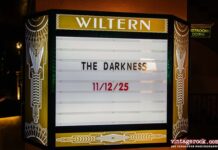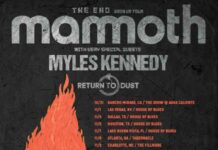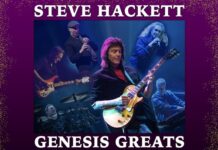Review by Shawn Perry
Pretentious. Overbearing. Pompous. These adjectives and many more like them have been used to describe Emerson, Lake and Palmer (ELP) — the progressive power trio whose career has spanned some 25 years despite what some of the critics think.
From 1970 to 1977, ELP was staking its claim on most AOR playlists, and consistently selling out baseball stadiums and hockey arenas. Consequently, ELP gained a solid reputation for doing things on a grand scale. Their personalities seemed to shine through their individual talents, showmanship and musical inventiveness. Fortunately, that aspect of ELP hasn’t changed much.
It isn’t enough that Keith Emerson just plays the keyboards with all the verve of a committed madman on the loose; he virtually surrounds himself with a barrage of keys, synthesizers and electronic towers. Occasionally, he rolls out a grand piano and tinkles out the kind of improvisational jam reserved for the likes of Dave Brubek and Bill Evans. Then he moves over to his beloved Hammond organ, and proceeds to assault, ride, pounce and stab it to bits. And just when things are getting a bit saucy, Emerson will occasionally position his body underneath the organ, pull it down, and punch out some gothic passage from the other side of the keyboard, all the while slowing going horizontal, somehow sustaining the weight from crushing himself. I’ve always figured Emerson for a frustrated guitar (and a true Hendrix disciple) who happened to pick up on the piano, got real good at it, but realized too late the limited mobility of the instrument. Well, we’ll just see about that…
As for Carl Palmer, the band’s drummer, it’s pretty much the same situation. Palmer isn’t just a drummer; he’s a percussionist. Which means that just about anything within shooting range is a possible target. Like Emerson, Palmer is encompassed by a myriad of drums, bells, chimes, tympanies and anything else he can defiantly clobber. Watching Palmer in action is like watching a football scrimmage: you never know the score until the game is over… and in the end it doesn’t really matter anyway because it’s just a scrimmage. But you still leave, scratching your head, wondering just what the hell happened…
In the middle of all this…stuff is…Greg Lake, the band’s singular voice, guitarist and bass player. Accessory-free, Lake functions as the balancing beam between the spontaneous shuffling of Emerson and Palmer. The only touch of decadence is a Persian rug he proudly stands on. Not to be outdone, Lake is also an excellent acoustic guitarist. His finger picking style and rich, baritone vocalizations are the cornerstones of some of ELP’s finest musical moments. Curiously, Lake has produced a majority of ELP’s albums, which proves his ear and vision are central to the band’s overall sound.
Many things have changed since the band’s hey day. It’s been a rough road these last couple years for ELP, but amazingly, they are no worse for wear. In 1994-95, the band’s future hovered over the outcome of an operation on Emerson’s hand. Contracting a severe form of arthritis, Emerson’s stylish, yet somewhat bombastic mode of delivery had taken its toll. Miraculously, Emerson recovered quickly, but evidently has adapted to a more subtle approach to his instrument.
An opening spot on Jethro Tull’s 1996 tour gave the band a chance to spread its wings more intrepidly, without carrying the brunt of responsibility. Consequently, ELP gave some excellent performances, pulling out discarded gems like “Bitches Crystal” along the way. Without a new album to support — unless you count the dual releases of ELP on the King Biscuit Flower Hour and the Isle of Wight performance — ELP is currently touring the Americas, headlining small venues, abbreviating their stage show, warmed up from the Tull gigs, and ready to stun, shock and amaze.
Their appearance at Humphrey’s was exceptional in its intimate power and fortitude. Indeed, the small San Diego seaside amphitheater is a long way from the California Jam, but it made for great theater to see ELP work within its confines. Kicking into “Karn Evil 9, 1st impression, Part Two” (which, for those unfamiliar with the title, starts off with the famous line, “Welcome back my friends, to the show that never ends…”), you would have thought the band was playing to a crowd of 50,000 or more. From there, they moved on to the Aaron Copland piece, “Hoedown,” another crowd-pleasing romp that showcases the tight interaction between the keyboards, bass and drums that ELP is so well known for.
From the small stage, ELP seemed to be making the most of the situation. Greg Lake treated the audience to an inspiring rendition of “From the Beginning,” while Keith Emerson demonstrated his placid ability to tickle the ivories on “Creole Dance” and “Honky Tonk Train.” Carl Palmer exhibited extraordinary precision and dexterity, especially in lieu of his returning to an all-acoustic set. Gone are the hollow thuds of the electronic pads he insisted on using during his days with Asia and ELP’s initial “comeback” five years ago.
For some unknown reason, ELP opted to not play any of their 90’s originals from “Black Moon” or “In The Hot Seat”. But they had no problem kicking into “Touch and Go,” a song culled from 1986’s Emerson, Lake and Powell (as in Cozy) album — perhaps a little more solid than the 90’s follow-ups with Carl Palmer reassuming the “P” in ELP. The crowd didn’t seem to mind — they wanted the BEEF, the old stuff, the “classics.” So within the obligatory readings of “Knife Edge” and “Lucky Man,” ELP threw in revitalized renditions of the aforementioned “Bitches Crystal” and “Take A Pebble” — the latter proving quite suitable for the setting.
In the end, all that was left were the epics and showstoppers. For their final number, ELP took two separate conceptual pieces — “Tarkus” and “Picture At An Exhibition” — and fused them into one, easy-to-swallow medley that clocked in at just under 15 minutes. For their first encore, ELP unleashed perhaps their most majestic tribute to Copland, “Fanfare For The Common Man,” and swung right into “Rondo,” an early Emerson lick that always brings out the best in the keyboardist. Emerson was surprisingly low-key during his rounds on the Hammond, but the effect was still intact. A Carl Palmer drum solo raised the ante as the crowd began to surge forth in hope of a tossed drumstick or discarded bandanna.
With demand in full bloom, the band came out for a second encore, launching right into the 1969 King Crimson classic that introduced the world to Greg Lake — “21st Century Schizoid Man.” As if this wasn’t enough of a treat (even without Robert Fripp), they seamlessly swerved into Leonard Bernstein’s “America,” another tune Emerson used to pound out during his days with the Nice.
Unlike previous appearances during the 70’s, the finale included no explosions or fireworks; just an enthusiastic and rambunctious reaction that actually forced the otherwise subdued security force to their feet.
And what does the future hold for a band like ELP — who have passed their peak, but still manage to emancipate enough energy to validate their continued existence? It’s hard to assimilate where exactly classic progressive rock bands like ELP and Yes fit in. Surely, techno and EMO bands owe a debt of gratitude to Keith Emerson, notably the first player to bring the synthesizer and all of its trappings to the concert stage. But the real question of ELP’s survival rests on what they have up their sleeve. Carl Palmer says they plan to record and release an epic, conceptual piece before the end of the millennium. He stated that there was a need for the band to get back to their roots, and do what they do best. With their last album in the cut-out bin because of its blatant and contrived commerciality, it seems as if ELP really doesn’t have a choice. We can only hope that such a move will spark a resurgence of interest in a band that always seemed ahead of its time.




















